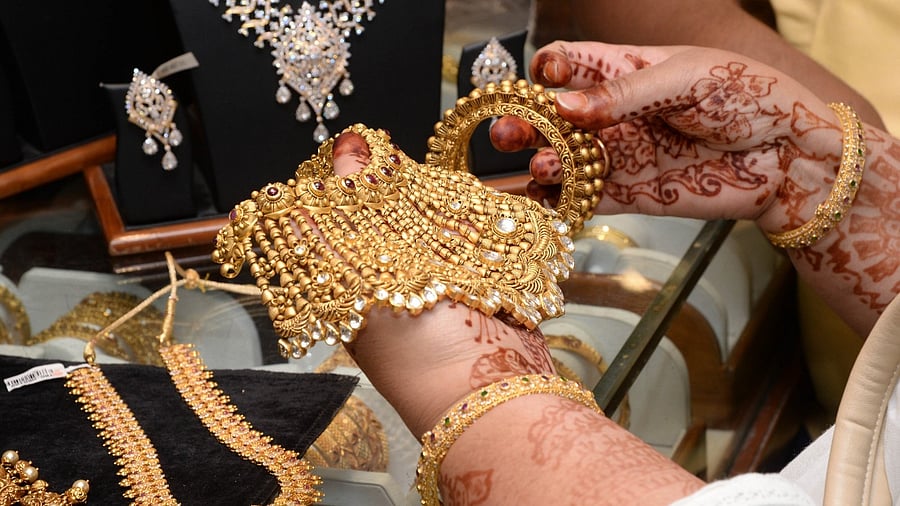
Representative image showing gold.
Credit: DHNS
Last week, I attended a family wedding and was struck by the sight of the bride, resplendent in shimmering gold jewellery. Curious, I asked my cousin how she managed to buy such a substantial collection, especially when gold prices are rallying in recent times. The answer was, “Thanks to ancestral inheritance.”
Indeed, without this time-honoured tradition of buying and passing gold across generations, such abundance might not have been possible. Indians’ enduring love affair with gold spans centuries. It is more than an adornment; it is an integral part of rituals and culture. Our ancestors, wise in their foresight, recognised the yellow metal as both a protector during crises and a hedge against inflation.
Gold’s importance in India extends beyond tradition. The metal is indispensable, with wedding-related consumption alone accounting for nearly 50% of annual gold demand. This unyielding cultural demand for gold, coupled with gold’s role as a safe investment to tide over crises and protect ourselves from uncertainties, drives its price and value.
Rising interest rates: Traditionally, gold and interest rates are negatively correlated. In times of economic prosperity, rising rates diminish gold’s appeal. Because gold as such offers no yield. However, when interest rates are low, alternative investment options generate minimal returns, making gold more attractive.
Globally, interest rates in the US have a profound impact on gold prices because the metal is traded in US dollars. For instance, following Donald Trump’s resounding victory in the US presidential race, gold prices dipped as investors anticipated stronger economic policies and a robust dollar. This created opportunities for Indian consumers to plan their wedding purchases and long-term investments.
Rupee-dollar equation: India’s reliance on gold imports ties its price to the rupee-dollar exchange rate. A weaker rupee results in higher gold prices in domestic terms.
Safe investment and hedging tool: In India, 60% of the demand for gold comes from rural consumption with purchases linked to agricultural prosperity. Farmers buy gold to create assets when the crop is good. It helps them generate funds during times of poor harvest.
Geopolitical factors: Geopolitical uncertainties, such as the Russia-Ukraine conflict, have made gold prices volatile. Amid escalating tensions, gold consistently proves its worth as a safe-haven asset.
Gold as an investment:
Despite price fluctuations, the demand for the yellow metal in the Indian markets is always on the rise. Gold is showing signs of recovery over the
last few days following Trump’s victory.
However, it still remains almost 5.5% below its October peak, giving an opportunity to those who are planning wedding purchases.
The 20-year and 10-year data clearly show gold has outperformed equity markets during global economic crises. Examples include the 2008 global financial crisis, the FY 2011-2012 US debt ceiling crisis, the Covid period of 2020-2023, and the current Russia-Ukraine war. During such periods, gold has consistently beaten benchmarks like the Nifty index.
Gold has been on a run since mid-February due to many reasons: expectation of interest rate cuts from the US Federal Reserve, geopolitical tensions like the Russia-Ukraine war, and chaos in the Middle East. It’s clear that during challenging economic times, investors tend to park their money in safer havens, and gold is a preferred choice. There are several reasons:
Gold protects against long-term inflation.
Unlike other physical assets, gold can easily be liquidated or used as collateral.
Investment in gold protects and helps diversify investment portfolios as it reduces the risk of volatility.
Gold remains a dependable asset during geopolitical or economic turmoil.
However, gold has its limitations. It does not generate returns or benefit from compounding. Unlike investments in stocks, the amount invested in gold does not contribute
to economic growth or wealth creation.
The government has reduced customs duty on gold imports from 15% to 6% in the 2024-25 Union Budget, the steepest cut since 2013. Gold jewellery also attracts 3% GST.
Gold bonds issued by the Government of India could be an option worth considering as their value increases with gold along with additional annual interest of 2.5%. These bonds, however, come with a lock-in period. The capital gains are tax-free, but the interest is taxable. Also, there are open-ended gold ETFs that track the value of gold closely and can be redeemed at any point.
According to reports, there is an increase of 1.5% in demand in early 2024 compared to the previous year. GOI plans to introduce 9-karat gold hallmarking to cater to the increasing demand and prevent fraud and chain-snatching crimes (reports suggest a 34% spike in chain-snatching crimes between 2021 and 2023). The hallmarking scheme is aimed at ensuring consumer protection and increasing the availability of gold jewellery to the middle class in the market. (Currently under BIS regulation, hallmarking is mandatory for six gold purity categories: 14KT, 18KT, 20KT, 22KT, 23KT, and 24KT.)
Amidst so many fluctuations, gold stands as a timeless hero for financial security. It has represented heritage and culture, provided stability, and remains an anchor offering value for the coming generations, making it one of the preferred choices of investments.
(The writer is an associate professor of finance at Christ deemed to be university, Bengaluru)